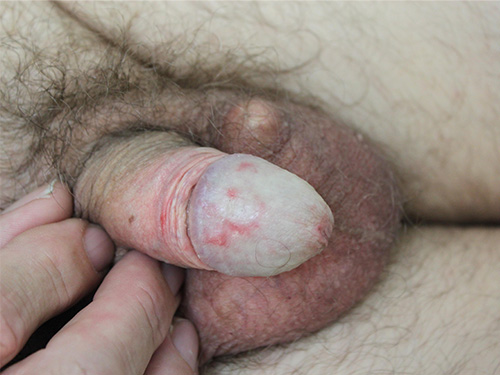Balanoposthitis in adult males
Balanoposthitis or balanitis in an adult male is usually caused by a dermatosis—if a dermatosis is suspected, refer the patient for dermatologist advice. Psoriasis, lichen planus, fixed drug eruptions, or cutaneous malignancies are the most common causes. Lichen sclerosus and Zoon plasma cell balanitis (see here for photos) tend to be the cause in uncircumcised males.


Balanoposthitis in adult males can also be caused by an irritant contact dermatitis with a superimposed Candida albicans infection. Candidal balanoposthitis occurs in a sexually active patient. It usually presents as itchy, red, scaly maculopapular lesions on the glans penis, and erythema and erosion of the foreskin. Take a swab for microscopy and culture to confirm infection; the swab may require gentle retraction of foreskin to obtain an adequate sample.
If C. albicans is identified, treat with a combination of topical imidazole and hydrocortisone. Use:
1hydrocortisone+clotrimazole 1%+1% cream topically, twice daily until the skin is clear and symptoms have resolved hydrocortisone + clotrimazole
OR
1hydrocortisone+miconazole 1%+2% cream topically, twice daily until the skin is clear and symptoms have resolved. hydrocortisone + miconazole
If the patient cannot tolerate topical therapy, or prefers oral therapy, use:
fluconazole 150 mg orally, as a single dose. fluconazole
Insufficient hygiene may contribute to candidal balanoposthitis if the patient does not always retract the foreskin when washing. Advise the patient to retract the foreskin and wash underneath (with a soap substitute) when bathing or showering, then to rinse off any soap, and dry under the foreskin before replacing over the head of the penis. A bland emollient (eg white soft paraffin) can protect the skin from urination and friction.
Recurrent candidal balanoposthitis can occur in patients with insufficient hygiene, or in patients with glycosuria (eg from diabetes or use of sodium-glucose co-transporter 2 [SGLT2] inhibitorsChesterman, 2020). If a newer oral hypoglycaemic agent is suspected to be the cause of recurrent candidal balanoposthitis, review and consider changing to an alternative oral hypoglycaemic agent. If candidal balanoposthitis is still recurrent, refer for dermatologist advice. In extreme cases, circumcision may be considered.
Apparent recurrence of candidal balanoposthitis can also be an irritation caused by sensitivity to vaginal carriage of C. albicans by a female sexual partner—see here for treatment in male sexual partners of females with C. albicans infection.
Balanoposthitis in adult males is rarely caused by Streptococcus pyogenes infection.
If balanoposthitis persists despite treatment, refer to a dermatologist. Skin biopsy may be required.
